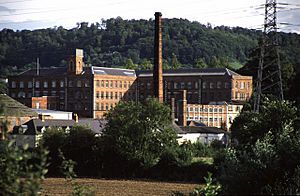Stanley Mills facts for kids
Quick facts for kids Stanley Mills |
|
|---|---|
 |
|
| Location | Ryeford, King's Stanley, Gloucestershire, England |
| Built | c. 1825 |
|
Listed Building – Grade I
|
|
| Official name: Main building at Stanley Mills | |
| Designated | 28 June 1960 |
| Reference no. | 1171285 |
|
Listed Building – Grade II
|
|
| Official name: Power loom shed at Stanley Mills | |
| Designated | 24 November 1976 |
| Reference no. | 1090761 |
|
Listed Building – Grade II
|
|
| Official name: Stanley Lodge at Stanley Mills | |
| Designated | 24 November 1976 |
| Reference no. | 1090762 |
|
Listed Building – Grade II
|
|
| Official name: Ancillary buildings at Stanley Mills | |
| Designated | 24 November 1976 |
| Reference no. | 1305674 |
| Lua error in Module:Location_map at line 420: attempt to index field 'wikibase' (a nil value). | |
Stanley Mills is an old woolen factory located in Ryeford, a village in King's Stanley, Gloucestershire, England. It was built a long time ago, in the early 1800s. The main building of the mill is very important, so it's officially called a Grade I listed building. This means it's a special historical place that needs to be protected.
Contents
Stanley Mills: A Historic Factory
Stanley Mills has been around for a very long time. Even before the current buildings, there were other mills on this same spot. The factory we see today was first built in 1813. It was made even bigger around 1825.
How the Mill Worked
The mill needed power to run its machines. It got this power from the water in the River Frome. At first, five large waterwheels helped the mill operate. Later, in 1834, a steam engine was added to provide even more power.
Who Owned Stanley Mills?
The first owner of the mill was Joseph Wathen. He sold it to George Harris and Donald Maclean in 1813 while it was still being built. In 1842, the Marling family took over. Later, in 1920, the company became a "public company" called Marling and Evans. This means that parts of the company could be bought and sold by many different people.
Important Buildings at the Mill
In 1815, a special house called a lodge was built for the mill owners. At the same time, other smaller buildings were constructed. These were used for storing materials and supplies needed for the factory. In 1854, a new building called a power loom shed was added. This shed held machines that wove fabric using power.
Challenges and Changes
In 1884, a fire broke out at the mill. It damaged the roof, but luckily, most of the main building was saved. The factory kept making woolen products for many more years. However, production at Stanley Mills finally stopped in the 1980s.
In 2017, there were new plans for the old mill. People wanted to turn the factory buildings into apartments and build new houses nearby. Today, the main building of Stanley Mills is on a list called the Heritage at Risk register by Historic England. This means it's a historic place that needs special care to protect it for the future.
Building the Mill: Architecture
The main building at Stanley Mills is shaped like an "L" and has five floors. Inside, it has a strong frame made of cast iron. This iron frame, with its columns and trusses, held up the red brick ceilings. The building was designed to be very strong and fireproof, which was important for a factory.
Materials Used
The iron parts for the mill came from a casting factory in Dudley. The bricks were from the London Brick Company. All these heavy materials were brought to the mill by water, using the Stroudwater Canal.
Other Buildings
The lodge house, where the owners lived, was built with a special brick pattern called Flemish bond and decorated with limestone. The other smaller buildings around the mill were made from similar materials. The power loom shed, which is four stories tall, is supported by strong limestone pillars that stand over the river.

